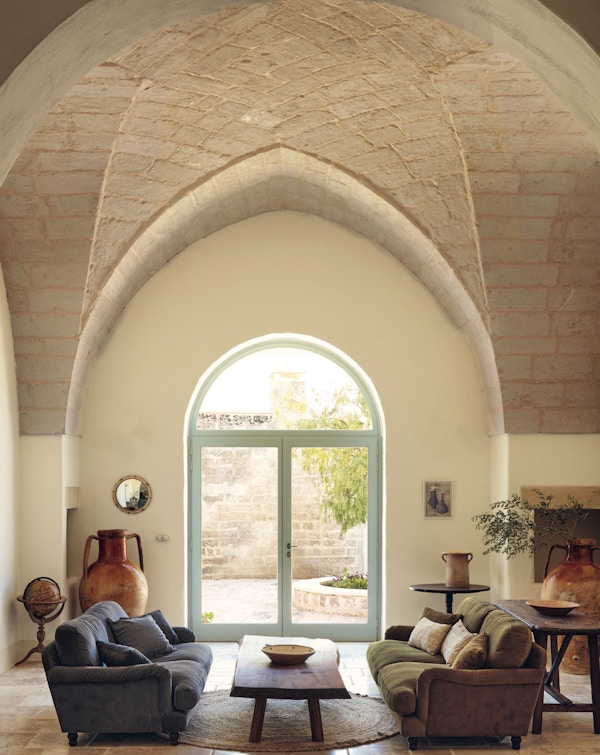Here she tells us what inspired her to write the book.
What inspired you to write The Reimagined Home, and how did your own experiences shape its philosophy?
As someone who loves colour and is passionate about sustainability – my previous styling campaigns include brands that champion both such as Houseof, Yes Colours and Trouva – I felt there was a lack of design diversity in the industry. Sustainability had become predominantly associated with neutral colour palettes and minimalism.
I wanted to redress this by creating a book that fused my penchant for creativity and joy without compromising on the eco credentials; to showcase sustainable design in all its forms, including colour, pattern and texture.

You highlight the homes of several creatives — what drew you to these particular lives, and what fresh perspectives do they bring to sustainable design?
I was drawn to the creatives in this book for their unwavering commitment to sustainable design without compromising on what felt right for them. For example, in the colourful Australian warehouse conversion of ceramicist and founder of Mud Australia, Shelley Simpson, walls have been placed on wheels to help future-proof her evolving business and family commitments.
In the Sunderland townhouse belonging to the founder of lifestyle brand Resinn, Kate Blower, traditional building techniques and materials including linseed oil and distemper paint have been used in contemporary ways to restore the 1920s property to its former glory.
Some people associate sustainability with compromise — how does your book challenge that notion and instead frame it as a joyful, creative process?
Self-expression and creative exploration spark joy. If you are drawn towards colour and pattern, you can still achieve a home with strong eco-credentials by incorporating vibrant textiles otherwise destined for landfill, seen in the Tunbridge Wells home of entrepreneur Jules Haines. Likewise, if you have a penchant for mid-century, you can embrace hand-crafted furniture and era-appropriate joinery, seen in the iconic Fender House, owned by Katie Brannaghan in Mount Martha.
How do you think the perception of sustainability within the home has changed over the years?
It has shifted from a niche concern to a mainstream value due to evolving family structures, an ageing population, and renewed focus on our physical and emotional wellbeing. As a collective we are also becoming more aware of the environmental impact our lifestyles and homes have, which is thankfully leading to a surge in demand for sustainable building materials, transparency of information and practices.

What are some of the biggest misconceptions about regenerative and adaptable design, and how can homeowners start shifting their mindset?
The biggest misconception about regenerative design is the confusion as to what it means. Many think regenerative design is solely focused on building materials such as hemp and limestone, whereas that is just one facet. Regenerative design is about finding ways, however small, for the human and natural world to coexist. This can be as easy and cost-effective as incorporating houseplants and areas of natural light within the home.
You discuss future-proofing spaces—can you share some key principles for designing a home that remains functional and beautiful over time?
A future-proof home is one that caters for the long-term needs of its occupants. Key aspects of this include growing your own fruit and vegetables, installing a heat pump for efficient and cost-effective energy use and using building materials that will stand the test of time. One of my favourite homes in the book, and a great example of stylish future-proofing, belongs to florist Kally Ellis in Puglia. The water for the household and surrounding agriculture is supplied via a restored well on the property, with Kally growing her own food using propagated plants.
For those working with a limited budget, what are some accessible, high-impact ways to embrace sustainable design?
Sustainability can be as simple as mixing furniture inherited from family members with the occasional new item to help save on landfill. If you love something, see if you can source it second-hand first. If not, make it a design classic in your home to be passed down generations.
For many, reinventing furniture they already own can be as simple and cost-effective as buying a second-hand lamp base and adding an existing shade, repainting an old chair instead of replacing it, or adding a mural to your wardrobe or cupboard door as a reimagined piece of artwork. In the Amsterdam home of photographer and stylist, Helma Bongenaar, the majority of items, including a chandelier made from ceramic spoons, have been remade using items rescued from skips.

How do you balance sustainability with aesthetics, ensuring that reclaimed or repurposed elements still feel fresh and cohesive?
Thankfully the stigma of reclaimed materials and the DIY horrors of the 90s are far behind us, and in their place is a modern craft movement that includes techniques such as Passementerie (the art of creating decorative trimmings such as tassels, braids and gold and silver cord) marquetry and chair weaving, which has resulted in the handcrafted becoming highly regarded as art forms within the home. Add to this the influx of young designers such as Baillie Mishler and Lauryn Menard at Prowl Studio and Partrcia Urquiola who are using recycled materials in revolutionary new ways, reshaping what sustainable design looks like.
In an era dominated by technology, how can homeowners cultivate a stronger connection to nature within their living spaces?
Maximising natural light by strategically placing windows and skylights, and incorporating tactile materials such as wood, stone, cork, rattan and bamboo will infuse your space with a sense of warmth that synthetic materials can not replicate. Adding indoor plants, water features, or nature-inspired artwork and colours reflective of nature will further enhance a connection to the outdoors.

What are some of the most inspiring transformations you've seen when people apply the principles in your book?
One of my favourite transformations in the book is the deep retrofit of a Victorian terrace belonging to Patricia and Gwen in Tottenham. Not only did they transform their kitchen with colourful low VOC paints, they also lined the walls with cork and lime-render for an air-tight thermal wrap that was then clad in handmade geometric tiles. The wow-factor moment of the renovation has to be the eye-catching curved ceiling, however, made up of 19 timber 'fins' that floods the space with natural light. It is the epitome of sustainable joy.
If someone could take away just one key idea from The Reimagined Home, what would you hope it would be?
That sustainability is not a 'one size fits all' aesthetic. It can be accommodated to reflect the lives of its occupants as they evolve, without veering into the mundane.

The Reimagined Home is available to preorder now at Amazon, Waterstones and Bookshop.org.
Images: Copyright Simon Bevan





